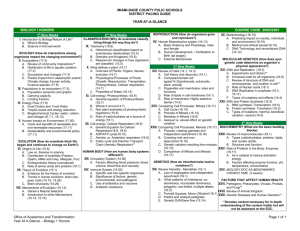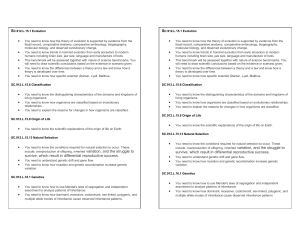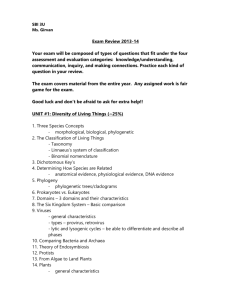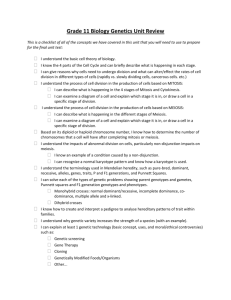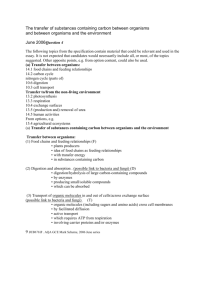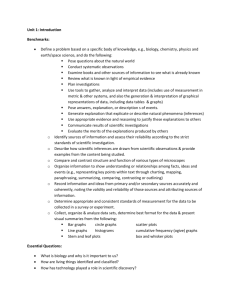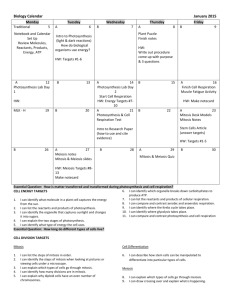Biology EOC - What you need to know.
advertisement
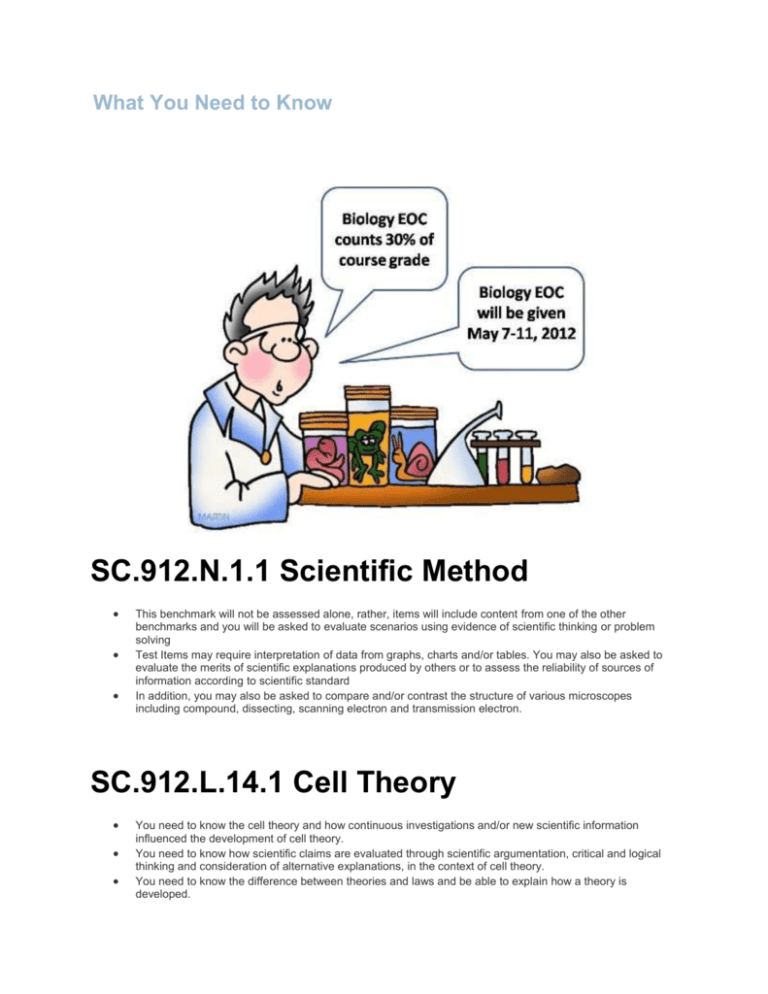
What You Need to Know SC.912.N.1.1 Scientific Method This benchmark will not be assessed alone, rather, items will include content from one of the other benchmarks and you will be asked to evaluate scenarios using evidence of scientific thinking or problem solving Test Items may require interpretation of data from graphs, charts and/or tables. You may also be asked to evaluate the merits of scientific explanations produced by others or to assess the reliability of sources of information according to scientific standard In addition, you may also be asked to compare and/or contrast the structure of various microscopes including compound, dissecting, scanning electron and transmission electron. SC.912.L.14.1 Cell Theory You need to know the cell theory and how continuous investigations and/or new scientific information influenced the development of cell theory. You need to know how scientific claims are evaluated through scientific argumentation, critical and logical thinking and consideration of alternative explanations, in the context of cell theory. You need to know the difference between theories and laws and be able to explain how a theory is developed. SC.912.L.14.3 Cell Structure You need to know the general structures of plant and animal cells and how plant and animal cells are alike and different. You need to know the general structures of prokaryotic and eukaryotic cells and how they are alike and different. You need to know how the structure relates to the function for the components of plant or animals cells. Structures you need to know are the cell wall, cell membrane, cytoplasm, plasmids, ribosomes, flagella, nucleus, nuclear envelope, nucleolus, chromatin, ribosomes, endoplasmic reticulum, microtubules, microfilaments, vacuoles, mitochondria, Golgi apparatus, chloroplasts, lysosomes, and cilia You need to understand the role of the cell membrane as a highly selective barrier that carries out passive and active transport. SC.912.L.16.3 DNA Replication You need to know the basic process of DNA replication and how it relates to the transmission and conservation of genetic information. You need to know that mutations in the DNA sequence may or may not result in phenotypic change and how mutations in gametes may result in phenotypic changes in offspring. You need to know the basic processes of transcription and translation and how they result in gene expression. You will also need to know that the basic processes of DNA are universal in organisms. You need to know that similarities in the genetic codes of organisms are due to common ancestry and the process of inheritance. SC.912.L.16.17 Mitosis and Meiosis You need to know the differences and similarities in the processes of mitosis and meiosis. And relate these to the processes of sexual and asexual reproduction. You need to know how mitosis and meiosis lead to genetic variation. You need to know the relationship between mutation, cell cycle, and uncontrolled cell growth potentially resulting in cancer. You need to know the cell cycle, including the process of mitosis and explain the role of mitosis in the formation of new cells and its importance in maintaining chromosome number during sexual reproduction. SC.912.L.18.1 Macromolecules You need to know the basic molecular structure and primary functions of carbohydrates, proteins, lipids, and nucleic acids. You need to know the role of enzymes as catalysts that lower the activation energy of biochemical reactions. You need to know how factors such as pH and temperature affect enzyme activity . SC.912.L.18.9 Photosynthesis and Cellular Respiration You need to know how photosynthesis and cellular respiration are related (that the products of one are the reactants of the other). You need to know the reactants, products and basic functions of photosynthesis, aerobic, and anaerobic respiration. You need to understand how ATP is connected with energy transfers within the cell. You need to know that photosynthesis stores energy while cellular respiration releases energy. SC.912.L.18.12 Properties of Water You need to know the specific properties of water that contribute to Earth's suitability as an environment for life. These include: cohesive behavior ability to moderate temperature expansion upon freezing versatility as a solvent hydrogen bonding and polarity SC.912.L.14.7 Plant Structure You need to know how the structures of plant tissues and organs are directly related to their roles in physiological processes. Plant organs are limited to roots, stems, leaves, flowers, fruit and cones. Physiological processes are limited to photosynthesis, cellular respiration, transpiration, and reproduction. Plant tissues are limited to meristematic, ground, dermal and vascular tissues. Plant structures are limited to cambium, guard cells, phloem, seed, stomata and xylem. SC.912.L.14.26 The Brain You will be asked to identify the major parts of the brain on a diagram. Items are limited to the following: cerebrum cerebellum pons medulla oblongata brain stem frontal lobe parietal lobe occipital lobe temporal lobe SC.912.L.14.36 Cardiovascular System You need to know the factors that affect blood flow through the cardiovascular system: blood pressure, blood volume, resistance, disease and exercise. You need to know how these factors affect blood flow. SC.912.L.14.52 Immune System You need to know the basic functions of the human immune system. You need to understand specific and non-specific immune responses. You need to know how the human immune system responds to vaccines and/or antibiotics. You need to know how genetic factors, environmental factors, and pathogenic agents affect both individual and public health. SC.912.L.16.10 Biotechnology You need to understand how biotechnology impacts individuals, society, and/or the environment. You will be given scenarios with specific examples and asked to determine the impact. SC.912.L.16.13 Reproductive System You need to know the basic anatomy and physiology of the human reproductive system. You need to know the process of human development from zygote to birth. For the male reproductive system, you will need to know the seminal vesicle, prostate gland, vas deferens, urethra, epididymis, scrotum, penis, and testes. For the female reproductive system, you will need to know the ovaries, oviduct (fallopian tube), uterus, cervix, and vagina. SC.912.L.17.5 Population Size You need to know how population size is determined by births, deaths, immigration, emigration and limiting factors. You need to be able to use data about population dynamics, abiotic factors, and biotic factors to explain a change in carrying capacity and population size in an ecosystem. You need to know that different types of organisms exist within aquatic systems due to chemistry, geography, light, depth, salinity, and/or temperature. You need to know the potential changes in an ecosystem resulting from seasonal variations, climate changes and/or succession. You need to know the positive or negative consequences that result from a reduction in biodiversity. SC.912.L.17.9 Food Webs and Energy Transfer You need to know how to use a food web to identify producers, consumers, and decomposers. You need to know the pathway of energy transfer through trophic levels and the reduction of available energy at successive trophic levels. You need to know how matter and energy move through the water and carbon cycles. SC.912.L.17.20 Human Impact You need to know how the actions of humans may impact environmental systems and affect sustainability. You need to know the costs and benefits of renewable and nonrenewable resources. You need to know that environmental policy decisions should be made after adequate monitoring of environmental parameters. You need to know how the environment and personal health are related. SC.912.L.15.1 Evolution You need to know how the theory of evolution is supported by evidence from the fossil record, comparative anatomy, comparative embryology, biogeography, molecular biology, and observed evolutionary change. You need to know trends in hominid evolution from early ancestors to modern humans including brain size, jaw size, language and manufacture of tools. This benchmark will be assessed together with nature of science benchmarks. You will need to draw scientific conclusions based on the evidence or scenario given. You need to know the differences between a theory and a law and know how a theory is developed over time. You need to know how specific scientist (Darwin, Lyell, Malthus, SC.912.L.15.6 Classification You need to know the distinguishing characteristics of the domains and kingdoms of living organisms. You need to know how organisms are classified based on evolutionary relationships. You need to explain the reasons for changes in how organisms are classified. SC.912.L.15.8 Origin of Life You need to know the scientific explanations of the origin of life on Earth. SC.912.L.15.13 Natural Selection You need to know the conditions required for natural selection to occur. These include: overproduction of offspring, inherited variation, and the struggle to survive, which result in differential reproductive success. You need to understand genetic drift and gene flow. You need to know how mutation and genetic recombination increase genetic variation. SC.912.L.16.1 Genetics You need to know how to use Mendel's laws of segregation and independent assortment to analyze patterns of inheritance. You need to know how dominant, recessive, codominant, sex-linked, polygenic, and multiple allele modes of inheritance cause observed inheritance patterns.
